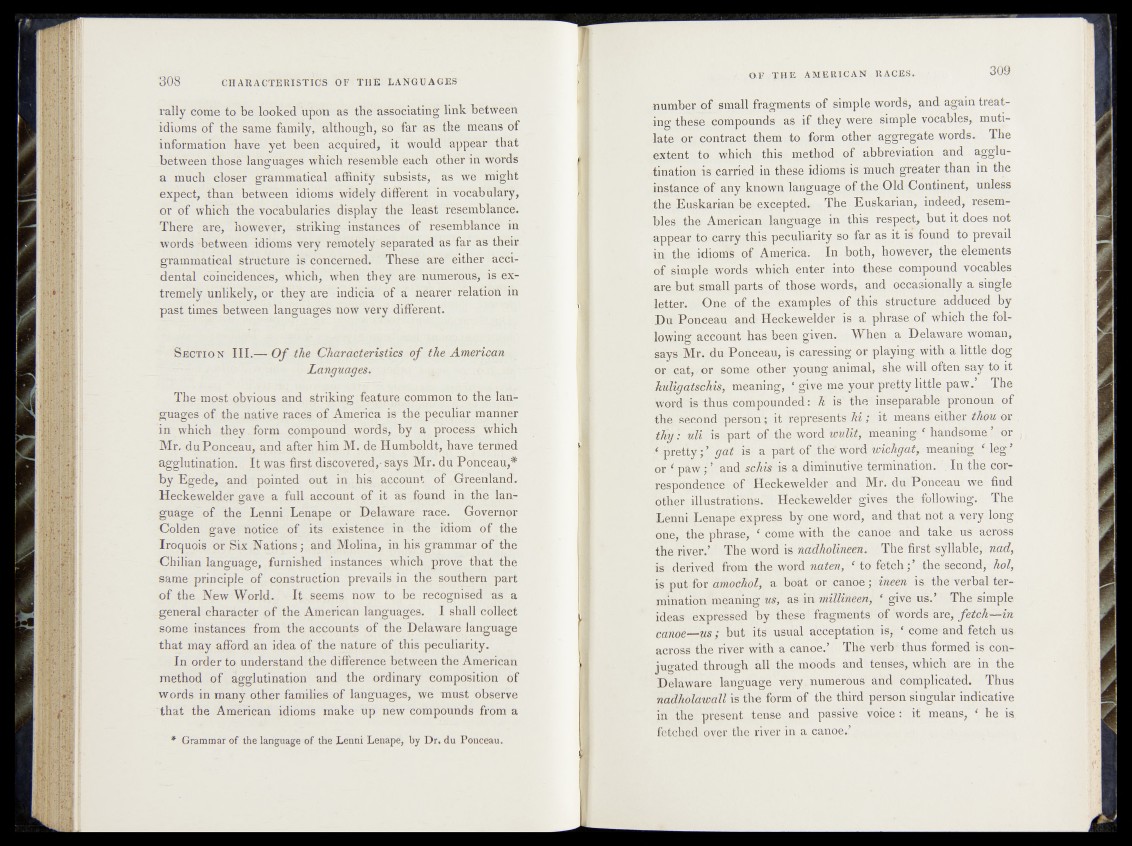
rally come to be looked upon as tbe associating link between
idioms of tbe same family, although, so far as the means of
information havé yet been acquired* it would appear that
between those languages which resemble each other in words
a much closer grammatical affinity subsists, as we might
expect, than between idionis widely different in vocabulary,
or of which the vocabularies display the least resemblance.
There are, however, -striking instances of resemblance in
words -between, idioms very remotely separated as far as their,
grammatical structure is concerned. These are either accidental
coincidences, which, when they are numerous, is extremely
unlikely, or they are indicia of a nêarer . relation in
past times between languages now very different.
S ection III.—- O f the Characteristics o f the American
Languages.
The most obvious and striking feature common to jth,e languages
of the native races of America is the peculiar manner
in which they . form compound words, by a process which
Mr, duPonceau, and after him M. de Humboldt, have termed
agglutination. It was first discovered,-says Mr. du Ponceau,*
by Egede, and pointed out in, his account of Greenland.
Heckewelder gave a full account of it as found in the language
of the Lenni Lenape or Delaware' race. Governor
Golden gave notice of its existence , in the idiom of the
Iroquois or Six Nations; and Molina, in his grammar of the
Chilian language,, furnished instances which prove that the
same principle, of construction prevails in the southern part
of the New World. I t . seems now to be recognised-as a
general character of the American languages. I shall collect
some instances from the accounts of the Delaware language
that may afford an idea of the nature of this peculiarity.
In order to understand the difference between the American
method of agglutination and the ordinary composition of
words in many other families of languages, we must observe
that the American idioms make up new compounds from a
* Grammar of the language of the Lenni Lenape, by Dr, du Ponceau.
numbprf of small .fragments of simpLe words, and again treat-
•ing.,these, compounds as - if ^ they; were., simple vocables, mutilate
or pOnttact them to form; other,.(aggregate words«. The
extent to which this.; rpethqd of abbreviation and agglutination,'
is1 carried in the^Mipms^jis; much greater than in the
instance .of any^bppwn language -of the Gld Continent, unless
the Èuskarian be- except®^ Thef Euskarian, indeed, resem-
blesi'.the Apa.p^f^tvJ^nguage in this^ -Fespgct, 'but it does, not
appear to; carry this p^filiarity^sb far as it is found to prevail
in ther, idionflC of Apierl«^< In both, however, the elements
of simple .words which enter jktto t j h ^ compound vocables
are butismall parts of those words, ‘ ©^^q|iÉ^ly a single
letteri-. One the-p}xam^S^i>f this stru c tu ^ adduced by
Du Bonceau, and Heckewelder is a'phrase of which thé, following;,
account ha^beeii given. * When a Delaware woman,
iS^ysriVIr. du Ponceau^ih: caressing or playing.with a lit^ d o g
ori-cdt^/ór some other young animarl, she will pftertsay to it
huligatschis, meaning, f.^iye me your pretty little paw.’ The
word is thds compouhddll^ k is tbé^inseparable: pronoun of
the second person; ifcJtepr'e^ehtslM;-'*it mean^gither thou ox
tTiy: uli is part of theWord 'wklit, meanijng^ handsbmer-dr
‘ pretty;’ gat is a part of .thé wordWc%:a^meaning Meg'
or § paw; ’ and schis is'ia diminutivdlprmihation. In the correspondence
of Heckeweld# aM Mr. du.P'once^we- find
other illustrations. Heckewelder’ gives the following.1 .The
Lenni Lenape express by onfe word, and that* hot- a very long
one, the phrase, ‘ come with the-canpe and takè, us Across
the river.’ The word is nadholineen. The first syllable, nad,
is derived from the word naten, ‘ to fetch;’ tbe^econd, hoi,
is put for amochol, a boat or canoe; iraeerc is the verbal termination
meaning us, as in mïllinèen, * give us.’ The simple
ideas expressed by these5 fragments;'of -\Vords are, fetch—in
canoe—us; but its usual acceptation's/ \ come and fetch us
across the river with a canoe.’ The verb* thus formed is conjugated
through all the moods and tenses, which are in the
Delaware language very numerous and Complicated. Thus
nadholawall is the form of the third person singular indicative
id the present tense and passive voice: it means,. ‘ he is
fetched over the river in a canoe.;’